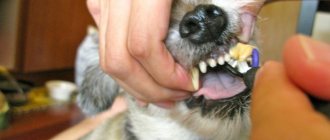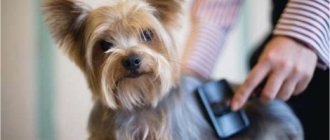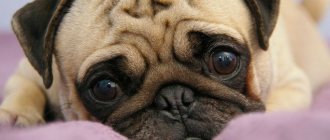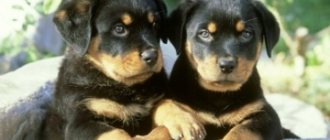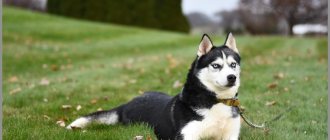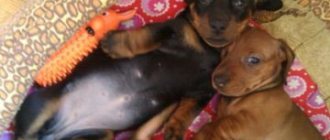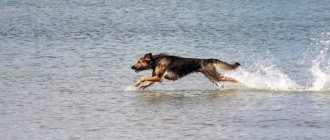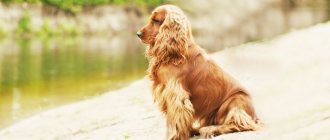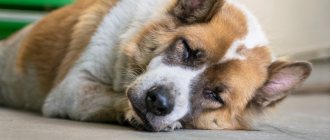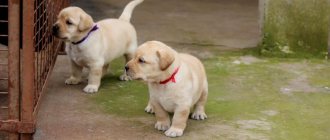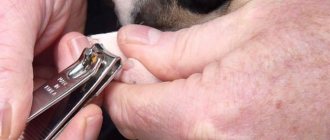Pugs are a well-known and very popular breed. These decorative dogs are the longest-lived among their smaller relatives and often live up to 15 years. Caring for a pug will not greatly burden the owner, provided that he is familiar with the characteristics of the breed and performs all the necessary manipulations with the required frequency. From the article you will learn about the features of keeping an adult representative of the breed and a puppy, how much attention you will have to pay to the pet’s eyes, ears and fur, how to walk and vaccinate the dog.
Features of care and maintenance of a pug
The pug is a breed that can only be kept in an apartment or other residential premises. Such dogs are absolutely not suitable for life on the street.
Before you bring your pug puppy home, you need to prepare a place for him. The issue of choosing the location of the future pet should be approached responsibly - the bed should not be placed near a radiator or in a place with constant drafts.
Due to the specific structure of their muzzle and head, pugs often snore heavily. To ensure a restful sleep, the owners move the place to a secluded corner, pantry, balcony and other isolated rooms. This is absolutely forbidden to do! Pugs are very people-oriented; due to forced isolation, they can become depressed and get sick.
A dog bed should be chosen from a dense, easily washable material - it is better if it is natural. The filler must be hypoallergenic.
Photo: wikimedia.org
Eyes
A pug's eyes are one of the most vulnerable places. Due to their specific structure and the dog’s small stature, this organ is most susceptible to injury and inflammation.
Eye hygiene is carried out daily, removing mucus and dirt. Use a cotton pad moistened with a special lotion.
The owner should pay attention to the following symptoms:
- the appearance of pus, wet circles and crusts under the eyes;
- corneal erosion;
- eversion of the eyelid and prolapse of the eyeball.
In these cases, you should consult a veterinarian, since self-treatment may not bring results, but can lead to complications.
Teeth and oral cavity
Healthy Pug teeth should be straight and white, with smooth pink gums. These dogs' teeth are quite weak and require careful care. With age, a pug's incisors and canines become loose and fall out.
To maintain the health of your pug's teeth, you should not play games with him where you have to pull something out of his mouth.
Main problems:
- Tartar is a gray or brown plaque that leads to the formation of caries. For natural cleaning, you need to give bones or bone crumbs. The stone can be removed at the veterinary clinic. This must be done, otherwise the dog will lose the tooth;
- unpleasant odor from the mouth. As a rule, the smell is a consequence of the formation of tartar, which injures and leads to inflammation of the gums or gastrointestinal tract.
Timely hygiene of the mouth will help to avoid problems with the teeth of the animal, which may stop eating and drinking due to softening of the tooth enamel and constant pain.
Toothache may be a sign of otitis media. The problem of treatment must be resolved jointly with a veterinarian.
A puppy should be taught to brush his teeth from a very young age, massaging the baby’s gums and teeth with his hands to develop the habit. Subsequently, a special paste and a brush selected according to the size of the mouth are used. Hygiene procedures are carried out at least once a month.
Ears
Normally, healthy pug ears should be pink on the inside, closer to white. There should be no scratches or inflammation on the surface.
Once every two days, the ears need to be cleaned of wax, which is brown in color and should not have an unpleasant putrefactive odor. For these purposes, use a cotton pad or special wipes soaked in lotion.
If, after cleaning the ears, the dog shakes its head and diligently scratches its ears, this may be a signal of an allergy to the product used. It is better to refuse it.
Main problems:
- Otitis. A common occurrence in pugs. Symptoms: the dog shakes its head, fever, lethargy and refusal to eat, discharge and odor, redness and swelling of the ear. Self-treatment can be effective at the initial stage, but it is better to consult a doctor. You can alleviate your pet’s condition by instilling drops of “Ottipax”, “Ottinum”, “Bars”;
- Ear mites - otodectosis. Symptoms: hot ear, black plaque and crusts. The diagnosis is made on the basis of laboratory tests. You cannot start treatment on your own;
- Mechanical damage - the wound is treated with any antiseptic.
Claws
Nails are trimmed as needed. You need to be careful not to damage the pulp located inside the claw. This will cause severe pain to the dog and he may then react aggressively to nail trimming.
Particular attention should be paid to trimming the nails on the dewclaws: they do not reach the ground and do not grind down naturally. Pugs love to scratch their faces with their paws; a long claw on the dewclaw can lead to serious injury to the eye or its loss.
For cutting, a special tool is used, selected according to the thickness of the claw.
Wool
The pug's coat needs weekly brushing with a stiff, fine-toothed iron brush. During the molting period - daily.
For dogs participating in exhibitions, the procedure has special features: to maintain clear hair growth lines, the hair on the paws, chest, and neck is trimmed.
The animal should be washed as it gets dirty, but at least once a month, using a special shampoo for dogs with short hair. After the procedure, you can rinse the dog with water and vinegar (1 tablespoon per 1 liter of water) to ensure shine and avoid dry skin.
Treatment of skin folds
There are a large number of folds on the dog's body, especially on the muzzle. They accumulate dirt, eye discharge and dust. In the warm season, the contents of the folds become dry and inflamed.
The folds on the face should be cleaned twice a week using a cotton swab or napkin. Any antiseptic solution (chlorhexidine, hydrogen peroxide, etc.) is suitable for cleaning, but it should not contain alcohol. After cleaning, use baby powder.
If the skin in the folds is already inflamed, after cleaning it is lubricated with Levomekol and Malovit ointments.
Here is a short and visual video on how to care for a pug.
Preparing a place for a pet
The pug's sleeping place should be in a cozy corner. Do not place the bedding in a draft, near a radiator or on a walkway. Placing a puppy in a closet or storage room is strictly prohibited. Under no circumstances should you isolate your baby. It is also important to designate a place in the kitchen where the dog will eat. It is best to purchase special bowls on a tripod for these purposes. For leisure, a pug can use both a standard bedding and a small cozy house, which can be purchased at a pet store.
The pug's sleeping place should not be in a draft
If there are children in the house, it is important to prepare them for the dog's arrival. It is necessary to explain that a pet is a living creature that should not be disturbed from resting.
What to buy in advance
What you will need to keep a pet of this breed in an apartment:
- bedding - approximately 50x50 cm, dark shades of fabric are recommended;
- covers for bedding (preferably);
- collar;
- leash;
- waterproof diapers and diapers for dogs (for the period of puppy growth);
- 2 bowls (for water and food);
- tripods for bowls (optional);
- special shampoo;
- nail clippers;
- wet wipes (hypoallergenic);
- furminator;
- clothes for winter (dogs do not tolerate frost well);
- tray (if you plan to not walk the dog often);
- hypoallergenic soap (preferably laundry soap);
- chlorhexidine;
- rubber toys;
- specialized food.
Waterproof diapers - essentials for a small puppy
It is important to understand that the puppy will cause a lot of trouble at first. You need to be patient and prepare for the fact that your baby will need care and constant attention.
Walking and inspection after the walk
It is advisable to walk your pug three times a day, playing active games with him. If necessary, your dog can be trained to go to the toilet in a litter box at home.
Short-haired dogs need additional heating - you will need more than one set of clothes.
After a walk, the dog must be examined, paying attention to the eyes and ears. Check for parasites and mechanical damage. Washing paws is a mandatory procedure that is taught from a very young age.
Necessary purchases
To care for a pug puppy you need the following equipment:
- bed and warm cape;
- warmer;
- two bowls;
- disposable diapers;
- litter tray;
- special toys for dogs;
- collar or harness, leash;
- muzzle (for an adult);
- shampoo;
- nail clipper;
- comb for wool;
- drops for eyes and ears;
- Toothbrush;
- cotton swabs, wet and dry wipes.
Dog vaccination
A newborn pug is protected by the mother’s immunity, but further protection of its health is the owner’s responsibility.
The result of vaccination is not only a healthy pet, but also the opportunity to obtain a veterinary passport. Vaccination is carried out in the clinic or independently, but they must make notes in the passport.
The breed often has allergies to veterinary medications, so it is better to get vaccinated in a clinic.
The first vaccination is given at the age of 2-2.5 months, repeated every two weeks. Further vaccination depends on the pace of development of the pug - after a complete change of teeth.
After vaccination, quarantine (2 weeks), abolition of bathing and monitoring of the animal’s condition are required.
Photo: pixabay.com
Main rules of nutrition
Pugs have sensitive digestion and are prone to gaining excess weight and developing allergies.
While following the general rules of nutrition, it is also necessary to focus on the individual characteristics of the pet.
The pug feeding scheme, starting from puppyhood, is as follows::
- From one month to two months, 6 feedings per day are provided.
- From the second to the fourth month, feeding is reduced by one, resulting in 5 feedings.
- 4-6 months – 4 feedings.
- From 6 months to a year – feeding is carried out 3 times a day.
- After a year, the period of active growth stops and metabolic processes slow down, so the dog can already eat 1-2 times a day.
- If the bitch becomes pregnant, after a month and subsequently, when breastfeeding puppies begins, she needs to feed more often, so the number of feedings increases up to 3 times.
You can feed pugs with natural products or special ready-made food.
Mixing natural products and dry food in one feeding is unacceptable..
If you are trying to feed your dog natural food, then you need to know about prohibited and permitted foods.
So, pugs cannot tolerate the following foods::
- Fatty meat and pork.
- Smoked products.
- Sweet foods, including chocolate.
- Beans.
- Spices and seasonings.
- Fried foods.
- Pasta.
- Fish that is found in rivers.
- Bones, especially tubular bones.
- Sometimes pugs do not tolerate oatmeal well, so it is best not to include it in the diet.
Foods that are healthy for pugs:
- Lean meat, it can be rabbit, veal, beef, poultry. venison, etc. In this case, all fat components are first removed from the pieces.
- You should be careful with chicken, as it often causes allergies in pugs.
- Cereals in the form of rice, buckwheat, etc. are useful.
- Vegetables.
- Despite the benefits of apples, you need to be moderate in their intake.
- Greenery.
- Sea fish without bones.
- Offal cooked or immersed in boiling water.
- Fermented milk products.
Breeding and participation in exhibitions
If the purpose of purchasing a pug is to obtain economic benefits, the pedigree and purity of the breed line are especially carefully checked.
Maximum attention is paid to the health of the animal before the first mating. A male pug should also undergo an examination to exclude the occurrence of pathologies in newborn puppies and complications in the parent.
For breeding, it is better to buy a girl, since not every male is suitable for mating. At the same time, the pedigree of the puppies will depend on the title of the father; the breeding schedule for such males is scheduled months in advance.
Dogs begin to be prepared for exhibitions at 1 month of age, and placed in a show rack at 2 months of age. By 9 months, the dog should stand for the prescribed amount of time and be able to show its teeth and bite. Patience and regular training are the key to success.
brief information
The homeland of these four-legged animals is China. The head is round, relative to the body it can be called large. The muzzle is flattened and has symmetrical wrinkles.
Pugs' eyes are large, slightly convex, and dark in color.
The ears are set high and fit tightly to the head, there are two types:
- Rose – in this case they are small in size and fit tightly to the head, with an open inside.
- Buttons are laid forward, their edges are pressed tightly to the head, the hole is closed.
The dog's body is short, stocky, with well-developed muscles.
The coat of pugs is short, silky, and comes in both dark and light colors (black fawn, silver, apricot-deer).
The character of the pets is cheerful, balanced, the dog is devoted to the owner and the whole family.
Read more about what a pug looks like here.
Owner reviews
Vera S.
Very interesting doggies. Our old man is almost 10 years old, he is vigorous and cheerful. The only serious disappointment is “brachycephalic syndrome”. At first he began to snore heavily, then fainted in the heat. Because of this feature, many airlines do not accept such passengers on board. We are being treated.
Regardless of health problems, they are excellent friends and favorites for children. Obedient, but often with asinine stubbornness.
Alexander R.
We bought our first dog like this after we saw it in one of the films. Excellent dogs, with such small sizes they are ready to protect the owner, without looking at the size of the offender. Cheerful, active, funny.
They just gobble up everything: edible and not. Especially puppies. Yes, their health is not very good: their teeth are weak.
An excellent companion breed: small, brave, loving. They do not require much care.
Hair cutting
In general, the dog does not need a haircut too much. But sometimes owners resort to a similar procedure during pug shedding.
Beige and fawn colored individuals are especially susceptible to frequent and heavy molting..
This haircut is called artificial shedding; in scientific publications it is called grooming or trimming.
The haircut is carried out using a clipper with a special attachment, leaving short hair measuring 3 mm.
It is necessary to trim the entire body and paws of the dog..
How to bathe properly?
The Samoyed does not need frequent bathing, as it does not have a specific odor. In addition, their wool has the property of self-cleaning. Therefore, your pet should be bathed no more than 3-4 times a year.
If your dog needs to be washed, follow these rules:
- You should not bathe your Samoyed until he is 3 months old.
- The water temperature for swimming should be approximately 37–38 degrees.
- First of all, the dog needs to be thoroughly wetted with water and soaped, since the Samoyed’s fur is very thick. This procedure will take quite a long time.
- The pet's head is washed last.
- Use shampoo for white, double-coated dogs when bathing.
- After applying the shampoo, rinse the animal thoroughly so that no shampoo particles remain on the fur.
- Wrap the Samoyed in a large towel, gently blot the coat and dry with a hairdryer.
IMPORTANT! During and after bathing, be sure to praise your dog and talk to him gently.
What to feed?
Let's figure out what to feed puppies of this breed, and start with natural food. But remember that not all products are beneficial for four-legged animals, and some can even be harmful to the animal’s body. What to feed a puppy by month:
- A one-month-old pug needs to be given milk, it is better if it is goat milk, you can also give the animal low-fat cottage cheese and a little stuffed meat, mashed boiled vegetables.
- At one and a half months, a pug puppy can eat everything that he ate at 1 month and fresh raw liver.
- When the puppy is 2 months old, you can add fish (cod, pollock), which you first grind in a meat grinder and cook in boiling water.
- At three months, the pug is faced with a change of teeth, so it is necessary to add cartilage or veal bones (not hard ones) to the diet.
- At 4 months, a pug can be fed all the foods, like an adult, which means meat (lamb, rabbit, horse meat, lean beef, poultry), dairy products, but not milk, and better if it is cottage cheese, kefir, yogurt.
Also, dogs of this breed can eat some vegetables, namely zucchini, carrots, pumpkin, cucumbers, and bell peppers.
But remember that pugs cannot be given a specific list of foods for food, for example:
- Sausage, sausages, hard bones.
- Raw chicken and raw fish.
- Smoked, salted, pickled products.
- Sweet products.
- Grilled meat.
- Mayonnaise and ketchup.
- Dishes with seasonings.
By following the dietary guidelines for pugs, your dogs will be full of energy and enjoy good health.
What to do if your pug won't let you cut its nails?
Most often, when cutting nails, the dog begins to resist. In this case, you will need the help of outsiders .
One person fixes the dog’s body, the other trims the dog’s claws.
If you don’t have an assistant, you can do it yourself. First, shake the animal by the withers until it calms down.
Then the paw is taken, the claw is trimmed, while the pug needs to be praised, then the same is done with the other fingers.
That is, the dog must understand that while it is undergoing the grooming procedure, it will be praised and given a treat. And if she throws a tantrum, they will shake her by the withers and in the end they will carry out the procedure anyway.
Standards
The first descriptions of the pug breed were officially approved in Great Britain in 1888. To date, they are the final approved standard.
| Purpose | Decorative and companion dog |
| Apartment | |
| Country of origin | China |
| Time of origin | Around 600 BC uh |
| Behavior | Moderately active, often self-confident. |
| General form | Square, with strong muscles. |
| Head and muzzle |
|
| Frame | Strong, muscular |
| Breast | Well developed, with wide ribs. |
| Back | Straight and strong. |
| Neck | Curved in an arc, with a mane. Quite long and elongated. |
| Limbs | Medium length, powerful, parallel. Hind legs with fat thighs. |
| Tail | Tight, in the form of a curl, located high. It is a big advantage if the tail is curled into a double curl. |
| Gait | With the rear end wobbling. |
| Wool | Short, thin, shiny. |
| Color | Silver, fawn, apricot, beige, brown, white, black. Markings on the face in the form of a mask with a contrasting color are required. |
Communication
Hamsters are far from the most sociable rodents, since in nature they live strictly alone. At home, keeping a hamster should also be solitary; if there are several animals, then there should be several cages. Such a pet also does not strive to communicate with the owner, so you will have to spend a lot of time taming an independent rodent.
There are certain rules of communication; if they are not followed, the hamster will show fear and aggression, irritating the owner. In the first days after purchasing the animal, it is better not to disturb it at all, no matter how much you want to cuddle the fluffy little ball. It will take about a week to get used to the new home, and at the same time to the voice and smell of the owner. At this stage, it is recommended to say your pet's name while feeding.
Domestic hamsters differ little in temperament from their wild counterparts; they must be patiently trained to be handled so that communication brings joy to both the owner and the pet. With hamsters, the main remedy is food reinforcement - you need to teach the baby to take a treat from the palm of your hand. Gradually the rodent will get used to the hand, then it can be pulled out of the cage
Handle the animal with care - the tiny animal can be injured if it jumps out of your hands or is held too tightly. The safest thing to do is to wrap your palms around it, forming a “house”
Contraindicated:
- wake up the animal;
- take from above, from the back (association with a predator attack);
- make sudden movements (even if bitten, you need to remain calm).
Caring for your hamster should include daily interaction. If you do not pick up your pet for a long time, a “rollback” will occur, and taming will have to start again. Contact should occur when the animal is active (in the evening).
Using a furminator
Furminator will help solve the problem of shedding in pugs, when dead fur sticks to furniture, clothes and other household items.
This tool, which looks like a small rake and, in fact, is an improved version of a comb for dogs, will help get rid of dead, but lingering undercoat in the fur, without affecting or damaging the coat..
For pugs, small furminators are suitable, designed for short-haired medium-sized dogs, with a working surface length of approximately 4-5 cm and fairly short teeth.
When choosing a furminator for a pug, you should give preference to products from well-known companies rather than their cheaper and, often, lower quality analogues.
You need to use the furminator in the same way as a regular comb: calmly and slowly, without pressure or jerky movements, comb your pug with it, which it is advisable to wash and dry before using this tool, and clean and disassemble all places with tangled or matted hair by hand or with using a regular comb.
It is unacceptable to pull the furminator or try to comb matted fur with it: this not only causes discomfort to the pet, but can also lead to damage and breakage of the tool..
Taking care of your health
A dog, even if it lives at home and does not come into contact with street animals, must be vaccinated against common canine diseases. This will protect both your pet and all family members. It is better to check the vaccination schedule with your veterinarian. He will also tell you when the puppy can be taken outside.
In addition to vaccination, it is necessary to purchase an anti-flea collar or drops on the withers, which have an insecticidal effect. If the infection is already evident, then this will not be enough: first, the puppy attacked by parasites must be bathed with insecticidal shampoo.
Sometimes it is necessary to take anthelmintic drugs. However, you should not stuff your dog with them again - they are harmful for him too. If you suspect the presence of a disease, it makes sense to get tested: many veterinary clinics today have the ability to conduct laboratory tests.
Description of the breed
Pugs are very sociable creatures. They need love, affection, and sometimes they are even too intrusive. Do not get this breed if you don’t have enough time for communication - dogs cannot stand loneliness.
That is why it is not recommended to arrange a place for them to rest in a secluded place. But keep in mind that short-nosed dogs snore heavily and pugs are no exception.
Despite the apparent clumsiness, this is an active, inquisitive dog. She quickly remembers her name. He will be equally happy to lie on the couch with you, fool around with younger family members, or accompany you on a walk.
The main characteristics of these dogs are:
- short – up to 33 cm height;
- large head with a short square muzzle, thick neck;
- round, bulging eyes;
- stocky, muscular body;
- wide chest;
- strong short legs;
- high-set tail in a ring;
- short, smooth coat with soft undercoat;
- The weight of an adult dog is from 6 to 8 kg.
The color ranges from light silver to black. Dogs with light, beige fur have black spots on their faces that look like a mask.
This breed is good for single or elderly people, as well as for families with children, since pugs are not aggressive, allow you to take care of themselves, and tolerate children's pranks in a friendly manner. They get along well with other dog breeds and other types of pets. The dogs are smart, quick-witted, and easy to train to the litter box. Keeping a pug does not present any difficulties, however, some structural features of the animal’s face require daily attention.

